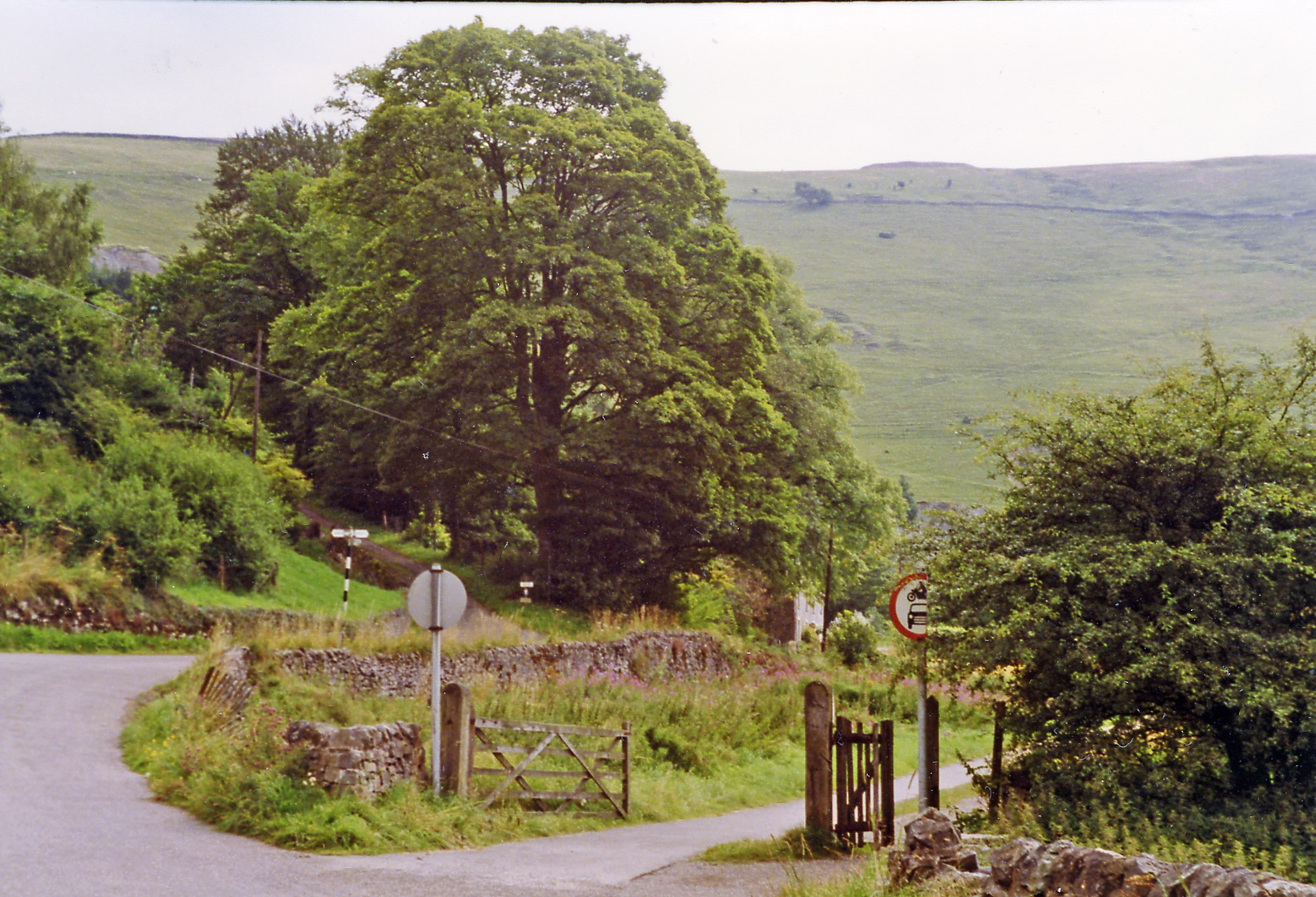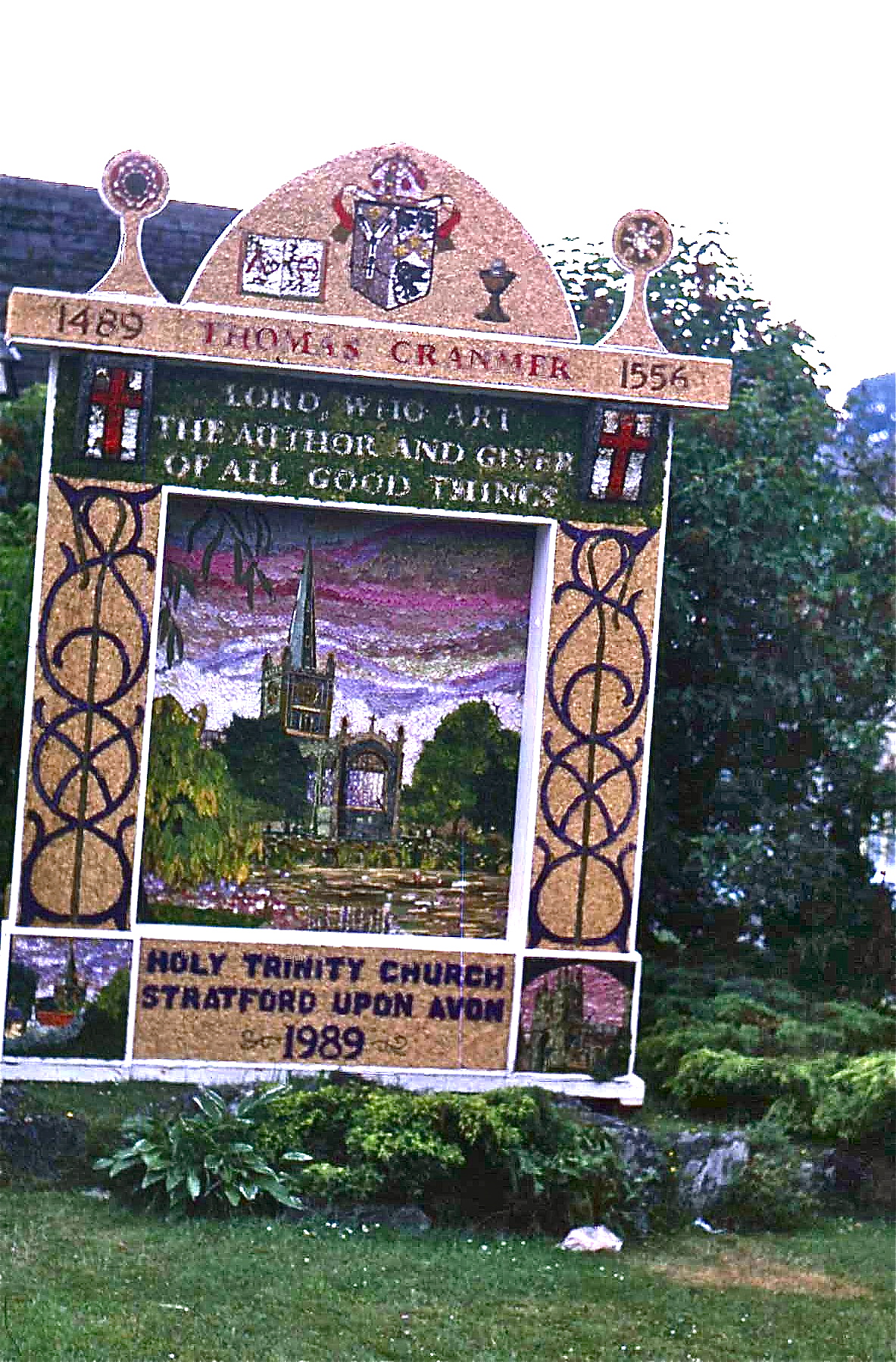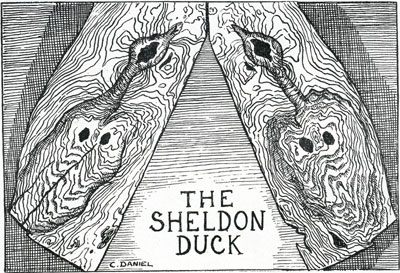|
Ashford Black Marble
Ashford Black Marble is the name given to a dark limestone, quarried from mines near Ashford-in-the-Water, in Derbyshire, England. Once cut, turned and polished, its shiny black surface is highly decorative. Ashford Black Marble is a very fine-grained sedimentary rock, and is not a true marble in the geological sense. It can be cut and inlaid with other decorative stones and minerals, using a technique known as pietra dura. History The mineral has been used decoratively since prehistoric times; the first recorded customer was Bess of Hardwick in 1580. Henry Watson, the uncle of Derbyshire geologist White Watson, is regarded as one of the key figures in the development of the local industry of inlaying Ashford Black Marble in the 1750s. He owned a water-powered mill at Ashford in the Water. There was a thriving trade in the manufacture of urns, obelisks and other decorative items from Ashford Black Marble during the late 18th and early 19th century. John Mawe had a museum i ... [...More Info...] [...Related Items...] OR: [Wikipedia] [Google] [Baidu] |
Pietra Dura Ecton Hill
{{disambiguation, given name, surname ...
Pietra means "stone" in Italian language. It is also rarely used as a given name (feminine of Pietro, ''Peter''), corresponding at almost to Petra. It may refer to: People * Pietra Brettkelly (born 1965), New Zealand film director * Pietra Montecorvino (born 1962), Italian singer and actress * Pietra Rivoli (born 1950s), American economist * Pietra (surname), an Italian surname Other uses * Pietra Brewery, a Corsican brewery * La Pietra, a school in Honolulu, Hawaii See also * * *Peter Pietras (1908–1993), American soccer player *Pietro, given name *Pietrari (other) *Petra, a city in Jordan *Petra (other) Petra is the Nabataean kingdom capital's archeological site, carved in the desert rock of (Trans)Jordan. Petra, PETRA or Petria may also refer to : Places and jurisdictions Mediterranean Greece * Petra (Corinthia), a town of ancient Corint ... [...More Info...] [...Related Items...] OR: [Wikipedia] [Google] [Baidu] |
Derby Museum And Art Gallery
Derby Museum and Art Gallery is a museum and art gallery in Derby, England. It was established in 1879, along with Derby Central Library, in a new building designed by Richard Knill Freeman and given to Derby by Michael Thomas Bass. The collection includes a gallery displaying many paintings by Joseph Wright of Derby; there is also a large display of Royal Crown Derby and other porcelain from Derby and the surrounding area. Further displays include archaeology, natural history, geology, military collections and world cultures. The Art Gallery was opened in 1882. History The museum can trace its start to the formation of the Derby Town and County Museum and Natural History Society on 10 February 1836. The society was housed by Full Street Public Baths but it was a private society funded by its members' subscriptions. Its collections were created by donations initially from Dr Forrester who had been a President of Derby Philosophical Society. The patron of the Museum Society was ... [...More Info...] [...Related Items...] OR: [Wikipedia] [Google] [Baidu] |
Ecton, Staffordshire
Ecton is a hamlet in the Staffordshire Peak District (). It is on the Manifold Way, an walk and cycle path that follows the line of the former Leek and Manifold Valley Light Railway. Population details as at the United Kingdom Census 2011, 2011 census can be found under Ilam, Staffordshire, Ilam. Ecton Mines, Copper and lead mining at Ecton Hill The village is overlooked by Ecton Hill, which has probably been mined for copper and lead since the sixteenth century. It was leased by the owner the Duke of Devonshire until, in 1760, the fourth duke decided to work it on his own account. Within fifty years, it became the richest individual copper mine in England producing over sixty thousands tons of ore. Until 1769, when the fifth Duke, William Cavendish, 5th Duke of Devonshire, William Cavendish, opened his own works at nearby Whiston, Staffordshire Moorlands, Whiston in the River Churnet, Churnet Valley, the ore was carried to Denby by packhorse for smelting. Much of the copper w ... [...More Info...] [...Related Items...] OR: [Wikipedia] [Google] [Baidu] |
Buxton Museum And Art Gallery
__NOTOC__ Buxton Museum and Art Gallery focuses its collection on history, geology and archaeology primarily from the Peak District and Derbyshire. The museum is located at Terrace Road, Buxton, England. The museum opens Tuesday to Saturday all year round and from Easter to the end of September is also open on Sunday and Bank Holiday afternoons. Admission is free. The building was erected in 1880 and originally served as the Peak Hydropathic Hotel. During the First World War, the Red Cross used it to care for wounded Canadian soldiers. The Buxton Free Public Library & Museum moved into the building in 1928, leaving the Town Hall."Welcome to Buxton Museum & Art Gallery, 2012 pamphlet published by the museum. Permanent collections The museum's permanent collections include: * Carboniferous limestone fossil record of the Peak District collected between 1900 and 1950; * Pliocene mammal evidence from caves and quarries throughout the Peak District; * The archives of archaeologist ... [...More Info...] [...Related Items...] OR: [Wikipedia] [Google] [Baidu] |
Tideswell
Tideswell is a village and civil parish in the Peak District of Derbyshire, England. It lies east of Buxton on the B6049, in a wide valley on a limestone plateau, at an altitude of above sea level, and is within the District of Derbyshire Dales. The population (including Wheston) was 1,820 in 2001, increasing slightly to 1,827 at the 2011 Census, making it the second-largest settlement within the National Park, after Bakewell. Tideswell Dale is a short limestone valley leading south from the village to the River Wye valley. Name There is some debate as to how the village got its name. The English Place Name Society accepts it as being named after a Saxon chieftain named Tidi, others that the name comes from a "tiding well" situated in the north of the village. This 'ebbing and flowing' well was declared to be one of the Seven Wonders of the Peak by Thomas Hobbes in his 1636 book ''De Mirabilibus Pecci.'' Tideswell is known locally as ''Tidza'' or ''Tidsa''. In addition, lo ... [...More Info...] [...Related Items...] OR: [Wikipedia] [Google] [Baidu] |
William Martin (naturalist)
William Martin (1767 – 31 May 1810) was an English naturalist and palaeontologist who proposed that science should use fossils as evidence to support the study of natural history. Martin published the first colour pictures of fossils and the first scientific study of fossils in English. Biography Martin was born in Mansfield in 1767. His father worked in the hosiery business, but he left to become an actor in Ireland with the stage name of Joseph Booth. His father was also an inventor and portrait painter who died in London in 1797.H. S. Torrens, 'Martin, William (1767–1810)', Oxford Dictionary of National Biography, Oxford University Press, 200accessed 13 Feb 2011/ref> Martin's abandoned mother, who was born Mallatratt, was also an actress. Whilst still a child he appeared on the stage, both as a five-year-old dancer, and later giving recitations. It was arranged for Martin to learn draughtsmanship from James Bolton in Halifax. From 1782 to 1785 he was with a Derbyshir ... [...More Info...] [...Related Items...] OR: [Wikipedia] [Google] [Baidu] |
Crich
Crich is a village in the English county of Derbyshire. The population at the 2001 Census was 2,821, increasing to 2,898 at the 2011 Census (including Fritchley and Whatstandwell). It has the National Tramway Museum inside the Crich Tramway Village and, at the summit of Crich Hill above, a memorial tower for those of the Sherwood Foresters regiment who died in battle, particularly in World War I. Built in 1923 on the site of an older tower called Crich Stand, the memorial tower is the destination of an annual pilgrimage on the first Sunday in July. It is above sea level and has 58 steps to the top. From there, seven counties can be seen (Derbyshire, Nottinghamshire, Yorkshire, Leicestershire, Staffordshire, Lancashire and Lincolnshire), including landmarks such as Lincoln Cathedral and the Humber Bridge. History In 1009 King Æthelred the Unready signed a charter at the Great Council which recognised the position and boundaries of Weston-on-Trent and several other manors inc ... [...More Info...] [...Related Items...] OR: [Wikipedia] [Google] [Baidu] |
Fluorite
Fluorite (also called fluorspar) is the mineral form of calcium fluoride, CaF2. It belongs to the halide minerals. It crystallizes in isometric cubic habit, although octahedral and more complex isometric forms are not uncommon. The Mohs scale of mineral hardness, based on scratch hardness comparison, defines value 4 as fluorite. Pure fluorite is colourless and transparent, both in visible and ultraviolet light, but impurities usually make it a colorful mineral and the stone has ornamental and lapidary uses. Industrially, fluorite is used as a flux for smelting, and in the production of certain glasses and enamels. The purest grades of fluorite are a source of fluoride for hydrofluoric acid manufacture, which is the intermediate source of most fluorine-containing fine chemicals. Optically clear transparent fluorite lenses have low dispersion, so lenses made from it exhibit less chromatic aberration, making them valuable in microscopes and telescopes. Fluorite optics are also ... [...More Info...] [...Related Items...] OR: [Wikipedia] [Google] [Baidu] |
Derbyshire Blue John
Blue John (also known as Derbyshire Spar) is a semi-precious mineral, a rare form of fluorite with bands of a purple-blue or yellowish colour. In the UK it is found only at Blue John Cavern and Treak Cliff Cavern at Castleton in Derbyshire. During the 19th century, it was mined for its ornamental value, and mining continues on a small scale. Etymology The most common explanation for the name is that it derives from the French , meaning 'blue-yellow'. The story goes that Blue John was exported to France where it was used by ''ormolu'' workers during the reign of Louis XVI (1774–91). However, there is no archival record of any Blue John being exported to France, and the early ''ormolu'' ornaments which use Blue John were being manufactured by Matthew Boulton of Birmingham in the 1760s. An alternative origin of the name derives from an old miners' name for the zinc ore sphalerite, which they called "Black Jack". Thus, the unique blue stone mined in these caverns could easily ... [...More Info...] [...Related Items...] OR: [Wikipedia] [Google] [Baidu] |
Castleton, Derbyshire
Castleton is a village in the High Peak district of Derbyshire, England, at the western end of the Hope Valley on the Peakshole Water, a tributary of the River Noe, between the Dark Peak to the north and the White Peak to the south. The population was 642 at the 2011 Census. History Castleton village was mentioned as ''Pechesers'' in Domesday Book in 1086 where "Arnbiorn and Hundingr held the land of William Peverel's castle in Castleton".''Domesday Book: A Complete Translation''. London: Penguin, 2003. p.750 This land and Peverel's castle were amongst the manors belonging to William Peverel that also included Bolsover and Glapwell. St Edmund's Norman church was restored about 1837. It has late 13th-century tracery and an ashlar-faced Perpendicular tower. Its box pews are dated 1661, 1662, 1663 and 1676. A medieval leper hospital (the Hospital of Saint Mary in the Peak) is thought to have been on the eastern boundary of Castleton, though some locals believe it to ... [...More Info...] [...Related Items...] OR: [Wikipedia] [Google] [Baidu] |
Barytes
Baryte, barite or barytes ( or ) is a mineral consisting of barium sulfate ( Ba S O4). Baryte is generally white or colorless, and is the main source of the element barium. The ''baryte group'' consists of baryte, celestine (strontium sulfate), anglesite (lead sulfate), and anhydrite (calcium sulfate). Baryte and celestine form a solid solution (Ba,Sr)SO4. Names and history The radiating form, sometimes referred to as ''Bologna Stone'', attained some notoriety among alchemists for specimens found in the 17th century near Bologna by Vincenzo Casciarolo. These became phosphorescent upon being calcined. Carl Scheele determined that baryte contained a new element in 1774, but could not isolate barium, only barium oxide. Johan Gottlieb Gahn also isolated barium oxide two years later in similar studies. Barium was first isolated by electrolysis of molten barium salts in 1808 by Sir Humphry Davy in England. The American Petroleum Institute specification API 13/ISO 13500, which governs ... [...More Info...] [...Related Items...] OR: [Wikipedia] [Google] [Baidu] |
Sheldon, Derbyshire
Sheldon is a village in the Derbyshire Peak District, England near Bakewell. It is best known for being the closest village to Magpie Mine, a lead mine with an engine house built in the Cornish style. Lead mining flourished around here in the 18th and 19th centuries. It is now scheduled as an ancient monument, and is the most complete example of a lead mine remaining in the Peak District. It is about 1050 feet above sea level. Sheldon is home of the Church of St Michael and All Angels as well. The church was erected in the 19th century with material derived from dismantling the former Chapel of Ease. Church The parish church is dedicated to Saint Michael and All Angels. Some sources give the dedication as just "All Angels" and many sources refer to the church as just a chapel. The present church, which seats 140, was built in 1864 near the site of the old chapel. The burial ground is to the east. Governance Sheldon is too small to have a parish council so administrative m ... [...More Info...] [...Related Items...] OR: [Wikipedia] [Google] [Baidu] |









